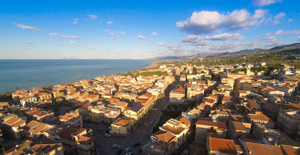Acquedolci territory of the Nebrodi Park

The territory of Acquedolci, not very extensive, is enclosed between ancient mountains and wide rivers; the town is located at the foot of Monte Vecchio (or San Fratello) and Castellaro lace, on a wide and green plateau that slopes gently towards the sea just in front of the Aeolian Islands.
The town was developed in the 1920s following the landslide of San Fratello (municipality of which Acquedolci was a village until 1969), thanks to the first general regulatory plan strongly desired by General Antonino Di Giorgio (national deputy and minister of war) which followed the birth of the country garden as a father does with a child, embellished with squares and spacious green areas.
At that time the aqueduct, the sewer system, the cemetery and numerous public housing (the "pavilions"), some noble houses and all the public buildings, monumental testimony, even if with the signs of the time, of Fascist architecture, were built. precursor of the city of foundation.
This territory has an ancient history, witnessed by important and numerous paleolithic finds (found in the last 150 years thanks to excavation campaigns held by eminent scholars) in a real outdoor museum that extends over the ancient marshes to the slopes of the Castellaro lace , where the Grotta di San Teodoro faces, a splendid and wide cavity that opens onto the wall of the high calcareous crag. Numerous bone remains of Quaternary fauna have been found here (elephants and dwarf hippopotamuses, hyenas, deer, wild boars, bears, donkeys ...) fossils of 200,000 years, lithic artifacts and ancient burials dating back to 11,000 years ago.
This huge heritage is now preserved in prestigious Sicilian and Italian museums, but in addition to the part left specifically in the outdoor trenches, which can be visited in place, some are exhibited in a municipal antiquarium from which it is advisable to leave for guided tours.
The historical information about the village dates back to Pliny the Elder, Cicero and Diodorus Siculus, when on the coast stood a scaro (carricatorum) and along the consular Pompea (on the line of the railway line) flourishing activities developed over time: water mills, trappeti for sugarcane, a tavern and a station for changing horses, a mill for the processing of wool.
In the early 1400s, King Martino built a tower that was fortified in the fifteenth century to be part of the sighting tower system wanted by Charles V, to protect the coast and a warehouse with a tavern around which a village was born, the first core of the "freshwater marine", name that has preserved until today.
Later the tower was incorporated into a complex structure that important families of the Kingdom of Spain erected in the seventeenth century, when it was transformed into a feudal residence with a splendid baroque facade and adjoining church of San Giuseppe. The negligence and indifference of all have reduced the whole complex in ruins, and, after so many vicissitudes, only in recent years the purchase by the City has allowed the beginning of recovery that could return to Acquedolci its history .
Reaching Acquedolci is very simple and from Acquedolci just as easily you can reach all the most significant places of the territory that falls in the Nebrodi Park; the country offers hospitality, good food, relaxation and holidays and, on the occasion of the renowned Carnival (an event with a solid tradition), also a joyful fun in the wake of the allegorical floats.